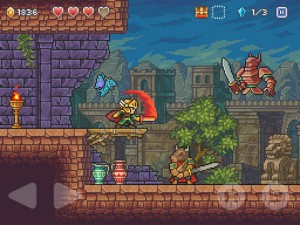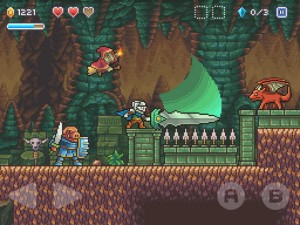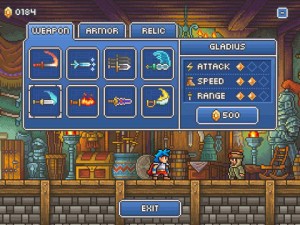Oh dear, it would appear that the dark wizard — whom has long been waging war upon the people of a peaceful kingdom — has finally found something that was thought forever lost: the legendary Goblin Sword. So goes the premise to Eleftherios Christodoulatos’ eponymously named Goblin Sword (out now, $1.99), the top-notch side-scrolling action-adventure where you take control of a blue-haired hero venturing forth to save the land. Along the way you’ll smite various wildlife denizens, collect valuable treasures, buy new equipment, seek out well hidden secrets, deal with devious traps, and topple a variety of brutal bosses.
 The first thing I am quite ecstatic to report about Goblin Sword is that the game’s controls are exceedingly good, which is rather important since the game rapidly goes from stupid easy all the way over to break-down-and-cry hard in no-time flat. On the screen’s left hand side are your left and right movement buttons, while on the device’s other end you have the game’s slash and jump buttons (which also allows the player to double-jump). Using these controls you’ll soon be pulling of the sort of precision double-jumping — all while attacking too — normally seen only in games such as I Wanna Be The Guy, and in some of Goblin Sword’s hidden bonus stages this precision will even be put to the test.
The first thing I am quite ecstatic to report about Goblin Sword is that the game’s controls are exceedingly good, which is rather important since the game rapidly goes from stupid easy all the way over to break-down-and-cry hard in no-time flat. On the screen’s left hand side are your left and right movement buttons, while on the device’s other end you have the game’s slash and jump buttons (which also allows the player to double-jump). Using these controls you’ll soon be pulling of the sort of precision double-jumping — all while attacking too — normally seen only in games such as I Wanna Be The Guy, and in some of Goblin Sword’s hidden bonus stages this precision will even be put to the test.
I would like to take a moment to reiterate what I just said, in hopes that it has a chance to properly sink-in, as this is not something you’d normally hear me proclaim about platforming titles on the iOS. You not only have controls up to the task of 100% reliably performing the kind of double-jumps seen in I Wanna Be The Guy, but Goblin Sword even has stages where you’re required to do this (minus IWBTG’s viciously hidden traps). The end result is a game of classical Hack ’n Slash platforming action that will even give legitimate frustration to many long-time gaming veterans, yet — unlike some other iOS platforming titles — not ever once be due to moments of control wonkiness.
The game itself is divided into a staggering 64 different levels, although all of which have been conveniently paced so as to nicely fit within the shortened confines of a mobile gaming lifestyle. Although finishing these stages is sometimes challenge enough, particularly if you’re dealing with Goblin Sword’s hidden bonus stages, like most mobile games a level isn’t truly done until you’ve completed it with honors. In that regard you’re going to be attempting to find three different crystals, as well as two different treasure chests, before you can truly consider any given stage to be properly finished for real.
 Although this can sometimes result in players trying to jump/fall into places you wouldn’t normally think to go, or otherwise insane to traverse, this will more often take the form of finding hidden paths that can’t be seen at first. Although these areas initially appear to be solid walls, they’ll actually reveal their true nature the exact minute your hero breaches their otherwise falsely-solid actually-open space. Thankfully these never devolve into purely smashing your character into every single wall just because it’s there, as there will most often be subtle environmental tells suggesting where secrets might be.
Although this can sometimes result in players trying to jump/fall into places you wouldn’t normally think to go, or otherwise insane to traverse, this will more often take the form of finding hidden paths that can’t be seen at first. Although these areas initially appear to be solid walls, they’ll actually reveal their true nature the exact minute your hero breaches their otherwise falsely-solid actually-open space. Thankfully these never devolve into purely smashing your character into every single wall just because it’s there, as there will most often be subtle environmental tells suggesting where secrets might be.
The most common hoard to find inside one of these comically oversized chests — whom are big enough that you could probably fit inside them — is a giant pile of money, which can then in turn be used to purchase various bits of equipment (but more on that later). On rarer, though never random, occasions you’ll find valuable artifacts — the likes of which aren’t sold — that can then be used to further bolster your own power, or perhaps to just better decorate your home (where you may also check on the status of achievements). Even if you never before realized that werewolves apparently have access to devastating flame breath attacks, you’ll surely never forget fighting him each time you gaze upon the suit of magical armor that you looted from the boss’s freshly slain corpse.
This gear — whether bought or found — will come in one of three specific forms: weapons, with which you smite your foes; relics, from which you can obtain additional perks (but only one at a time); and armors, which otherwise exist purely for cosmetic purposes. These weapons — beyond their visual appearance — are further broken down by how they perform in three areas: Range (how hard/easy it is to hit targets with them); Speed (obviously how fast you may swing the sword); and Damage (this one speaks for itself). Another — although not immediately obvious — factor that weapons have lies in how they work when you’ve just quaffed a magic potion, after which you’ll have a limited number of devastating attacks to launch (with the spell’s form controlled by your weapon held).
 The rarest of treasures that you’ll find in chests definitely has to be the life potions, which — upon finding four of them — your hero will permanently expand his life bar by an entire heart slot. This may not seem like much at first, but it really can sometimes be the difference between life and death (you’d be rather surprised how fast you can damage sponge up a lot of hits when you aren’t being perfectly cautious). In fact, I wasn’t even able to finish the first secret stage at all — let alone escape with all of the crystals — until after I’d already got my first bonus heart part way into Goblin Sword’s second region.
The rarest of treasures that you’ll find in chests definitely has to be the life potions, which — upon finding four of them — your hero will permanently expand his life bar by an entire heart slot. This may not seem like much at first, but it really can sometimes be the difference between life and death (you’d be rather surprised how fast you can damage sponge up a lot of hits when you aren’t being perfectly cautious). In fact, I wasn’t even able to finish the first secret stage at all — let alone escape with all of the crystals — until after I’d already got my first bonus heart part way into Goblin Sword’s second region.
Anyways — gameplay matters aside — Goblin Sword isn’t just a well-crafted side-scrolling action game, the entire package happens to be a rather impressive looking one as well. The lavishly colored — and rather detailed — pixel artwork forming all of the game’s enemies, background scenery, and weapons is heavily reminiscent of the graphics and vistas that used to be rather commonplace back during the long-passed Super NES era. Further accompanying this is a nice soundtrack, wherein I was especially fond of the standard music accompanying Goblin Sword’s second region (I know some argue that background music fails whenever it draws attention to itself, but I don’t always agree).
The end result is that Goblin Sword is a very enjoyable — challenging — and well presented overall package, that is sure to please those seeking a side-scrolling Hack ’n Slash adventure. I should probably reclarify something — if I didn’t make it properly clear to begin with — but Goblin Sword’s difficulty is usually not on the IWBTG level, that only occurs during the game’s secret stages. These secret stages are not required for winning the game (although they do often contain valuable gear), and are only made available after you’ve first collected absolutely all of the treasures hidden within a given region.
iFanzine Verdict: Eleftherios Christodoulatos’ Goblin Sword is a side-scrolling platform-jumping action game with extremely responsive controls, which is good as some of the game’s double-jumping challenges can reach IWBTG levels of difficulty. Filled with 64 different levels in which to slash enemies — as well as scour the countryside for hidden treasure — Goblin Sword is furthermore guaranteed to keep people busy for quite a while, even longtime gaming veterans. Finally, the entire package is totally covered within the initial upfront cost; meaning that Goblin Sword has absolutely no IAP-driven grinding for players to ever need worry about.

